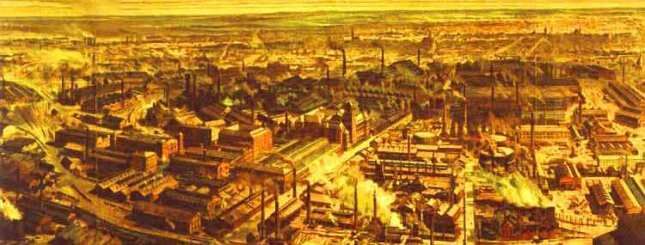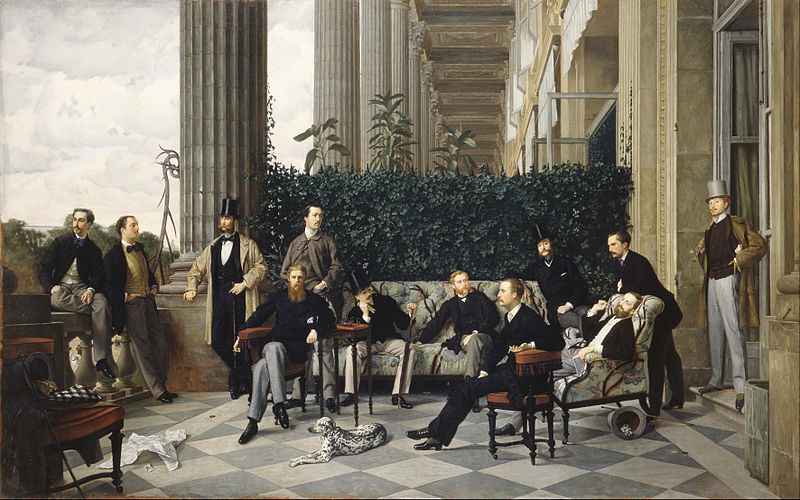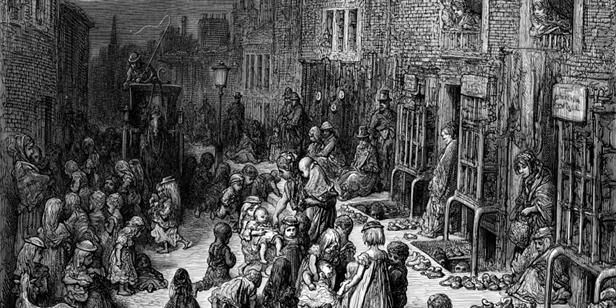As industrialization took hold in the UK, its impact on society became increasingly evident. First of all, industrialization is characterized by certain essential elements.
Industrialization is the spread of mechanization and a sharp increase in factory and plant work. Industrialization is also explained by the transition from an artisanal mode of production (goods made entirely by hand) to an industrial mode of production (goods made in factories).
With the advent of machinery, a new way of working was introduced, promoting the division of labour. With this new way of working, each worker performs a small, simple task in the manufacture of goods or merchandise.

The Division of Labour in a Factory
The first sectors to industrialize were :
-
textiles, for linen, blankets, etc;
-
metallurgy, for the construction of machinery, means of transport, etc.

A Typical British Industrial Town
Changes in agriculture forced poor peasants to leave the countryside to find work in the cities. This rural exodus favored the availability of labor in the early days of British industrialization. Later, when industrialization was well underway, the rural exodus accelerated. More and more peasants headed for the cities, hoping to improve their living and working conditions. In short, industrialization accelerated rural exodus and urbanization.
While the Industrial Revolution, which began in England, moved large numbers of people from the countryside to the city, it also transformed the organization of the social hierarchy. Two groups stood out: the bourgeoisie and the workers. These two social groups are deeply intertwined and dependent on each other, but despite this, they are very different and regularly clash.
The bourgeoisie

The Bourgeoisie in the 19th Century
During the Middle Ages, the bourgeoisie steadily increased its influence in society, first economically and later politically. During the Renaissance and the age of exploration, the British bourgeoisie amassed fortunes by trading with the new colonies. What's more, some of them gradually succeeded in getting elected as Members of Parliament.
Since industrialization, the bourgeoisie social group has owned the means of production (factories, natural resources and labor) and the capital. Politically, the bourgeoisie continues to progress, replacing the British nobility at the top of the political ladder with a majority of elected MPs in the Parliament of London. In short, the British bourgeoisie has moved up the hierarchy and represents the economic and political elite.
The workers
In factories, machines are operated by unskilled, untrained laborers. These people form a new social class: the workers, who exchange their labor power for a wage. They make up the majority of the urban population.
As factories spread across England, the demand for workers was enormous. However, the peasants and farm workers now seeking employment in the cities far outnumbered this demand. Right from the start of industrialization, the bourgeoisie, which controlled the means of production, found itself in a position of strength in relation to the workers, who wanted to work at any price, even for derisory wages.

A Working-Class Neighborhood in Great Britain
With the rapid and massive influx of rural populations (peasants and farm workers) into cities, it has been difficult to develop the infrastructure (roads, housing, aqueducts, etc.) needed to accommodate them. Generally speaking, this poor population found itself living in overcrowded, unhealthy neighborhoods. What's more, the workers' neighborhoods were located close to the factories, in an environment polluted by coal fumes and toxic water discharges.
In short, industrialization gave rise to a new social class, the workers, and enabled the bourgeoisie to rise to the top of the social pyramid. At the heart of these changes were class inequalities, which led to major workers' conflicts with the authorities (government and business leaders) to improve living conditions for workers.